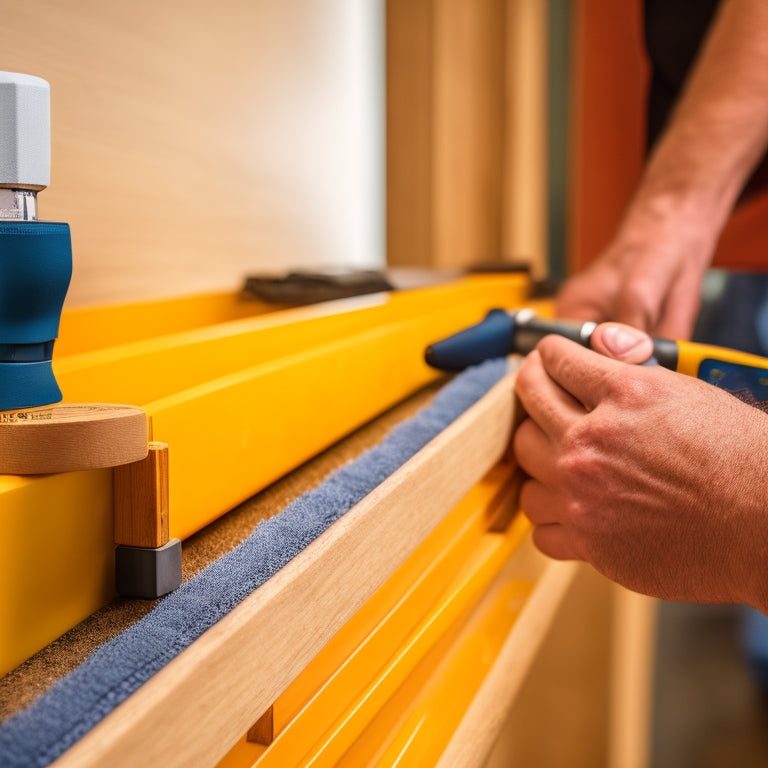
Expert Tips for Perfect Bathroom Cabinet Installation
Share
A successful bathroom cabinet installation requires meticulous planning and execution. Begin by gathering necessary tools and materials, including a tape measure, level, and stud finder, to guarantee accurate measurements and secure fastening. Next, plan the cabinet placement using the 'work triangle' concept to optimize space and consider the height, width, and location of fixtures. Finally, execute the installation process by confirming measurements, aligning with wall studs, and following manufacturer's instructions. By following these expert tips, you'll be well on your way to creating a functional and visually appealing bathroom environment, and uncovering the subtleties that elevate a good installation to a perfect one.
Key Takeaways
• Gather essential tools, including a tape measure, level, and stud finder, to ensure accurate measurements and proper installation.
• Plan cabinet placement using the "work triangle" concept to optimize space and ensure functional design and aesthetic appeal.
• Confirm accurate measurements to avoid errors and align the cabinet with wall studs for stability and secure fastening.
• Identify the ideal location for the cabinet, considering height, width, and location of fixtures, to enhance functionality and user experience.
• Follow manufacturer's instructions for correct mounting hardware and fastening to ensure a seamless and secure installation.
Prepare for a Successful Installation
Prior to commencing the bathroom cabinet installation, it is important to gather and prepare all necessary tools and materials to guarantee a successful and efficient process.
A tape measure, level, pencil, stud finder, and screwdriver are essential tools to have on hand. The stud finder, in particular, plays a significant role in locating wall studs, ensuring the cabinet is securely attached and stable.
Additionally, having the correct mounting hardware is crucial, as specified by the manufacturer's instructions.
Plan the Cabinet Placement
With the necessary tools and materials at hand, attention can now be turned to planning the best placement of the bathroom cabinet, a decision that will greatly impact the functionality and aesthetic appeal of the bathroom.
To achieve maximum space optimization, consider the 'work triangle' concept, where the cabinet is positioned to create a comfortable distance between the sink, toilet, and shower. This functional design approach guarantees a logical flow and efficient use of space.
Additionally, take into account the height and width of the cabinet, as well as the location of any plumbing or electrical fixtures. By carefully planning the cabinet's placement, you can create a harmonious and functional bathroom environment that meets your needs and enhances the overall user experience.
Execute the Installation Process
The bathroom cabinet installation process begins by identifying the ideal location for the cabinet, taking into account the precise measurements and layout of the bathroom to guarantee a seamless integration.
-
Precise Measurements: Confirm accurate measurements of the cabinet and bathroom layout to avoid any installation errors.
-
Proper Alignment: Align the cabinet with the wall studs to ensure stability and prevent future issues.
-
Secure Fastening: Follow the manufacturer's instructions for mounting hardware and firmly fasten the cabinet to the wall studs.
Frequently Asked Questions
Can I Install a Bathroom Cabinet on a Plaster Wall?
When installing a bathroom cabinet on a plaster wall, make sure to perform proper wall preparation by checking for damage and conducting plaster repair if necessary, then follow standard installation procedures to secure the cabinet to wall studs.
How Do I Handle Uneven Walls During Installation?
When encountering uneven walls, utilize wall anchors to provide extra holding power and filler compounds to level the surface, ensuring a secure and even bathroom cabinet installation that can withstand weight and moisture.
Are There Specific Screws for Bathroom Cabinet Installation?
When selecting screws for bathroom cabinet installation, consider screw head type, such as pan or hex, and screw material, like stainless steel or brass, which provide corrosion resistance and durability in humid environments.
Can I Install a Bathroom Cabinet Near a Water Source?
When installing a bathroom cabinet near a water source, prioritize moisture protection to prevent water damage and corrosion. Opt for waterproof materials and guarantee a watertight seal to safeguard your investment and maintain a hygienic environment.
Do I Need to Add Additional Support for Heavy Cabinets?
'When installing heavy cabinets, it's important to take into account the load-bearing capacity of the wall. Additional wall reinforcement, such as blocking or backing, may be necessary to guarantee stability and prevent structural damage.'
Related Posts
-

Vintage Metal Bathroom Storage for Industrial Look
If you're aiming for that chic industrial look in your bathroom, vintage metal storage is the perfect choice. These p...
-

Revamp Your Bathroom Drawers With Expert Tips
I'm ready to transform my bathroom drawers from cluttered chaos to serene sanctuaries. First, I'll empty and sort ite...
-

Innovative Miro Applications: Beyond the Usual
Miro's capabilities surpass traditional boundaries, offering a domain of innovative applications waiting to be explor...


